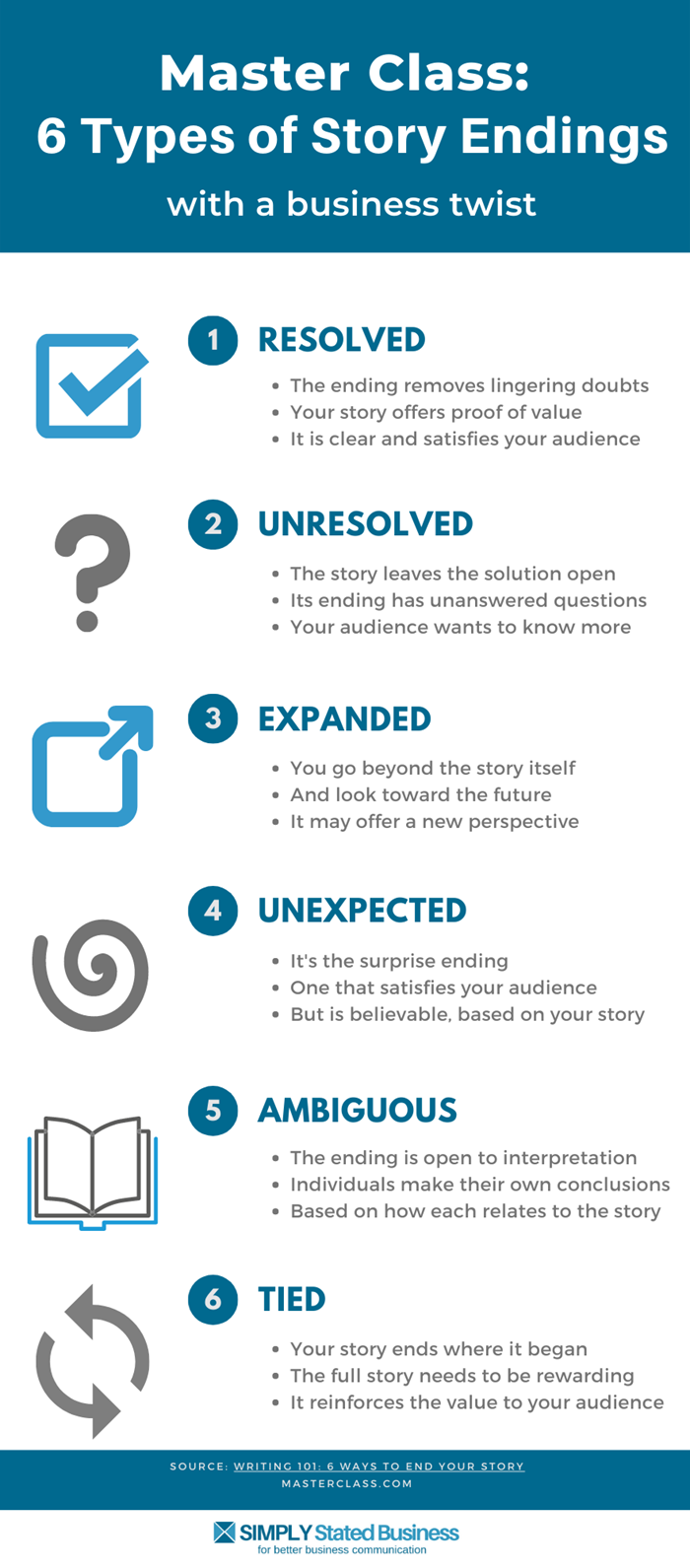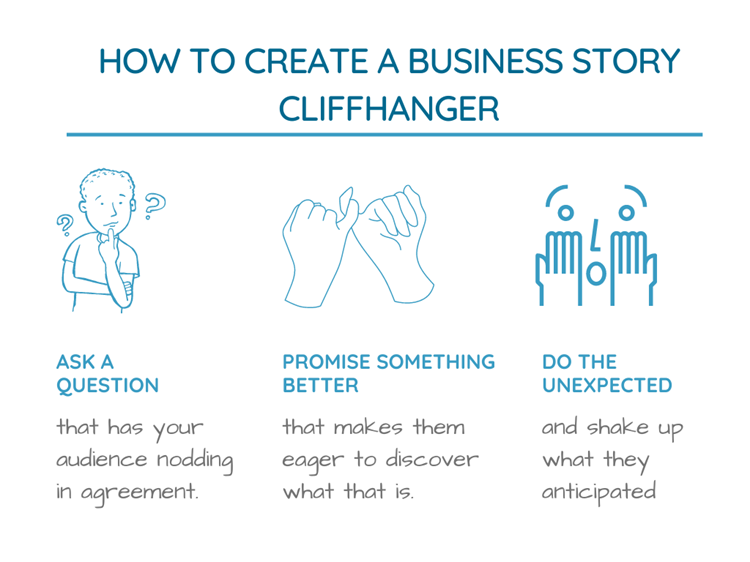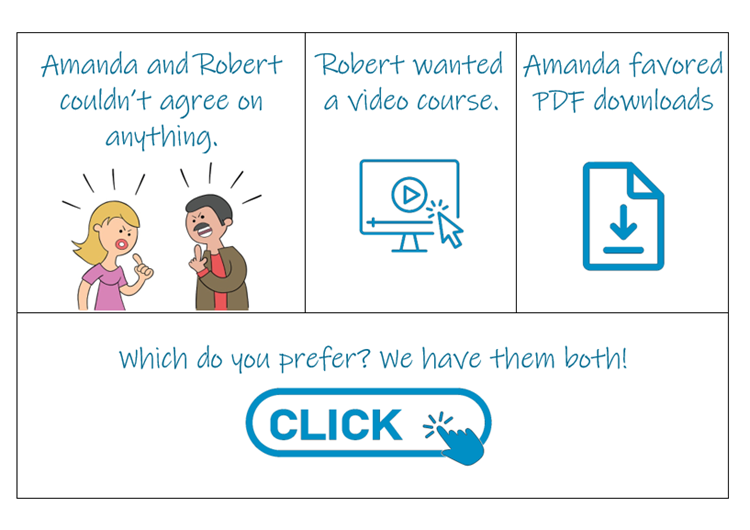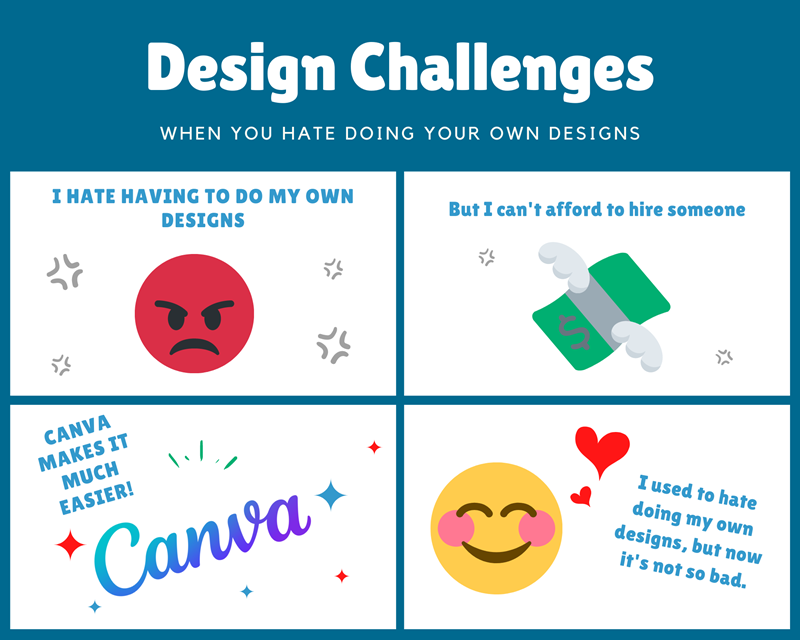Meet Joshua. He’s been practicing his business storytelling to snag the attention of his desired market.
Joshua starts out strong, but then his story endings slowly chug toward the finish line. By the time the story ends, his audience mentally checked out or moved on.
Don’t be like Joshua. Finish strong.
Master Class identifies 6 types of story endings. While Master Class features examples from well-known books, this post puts a business twist on the ending types.
Types of Story Endings
Regardless of the size or purpose of your business story, you want to finish strong. Your audience should remember your story beyond the time it’s told. But how many times have you encountered a Joshua-type at a presentation or while reading a story in print?
- It’s like reading a great novel and feeling let down by a weak ending.
- The only way you pick up another one of the author’s books is if you enjoyed others he or she wrote.
The same may be true in business relations. If you know and trust the person, you may let the feeble ending slide. You’ll give them another chance.
But imagine if it’s the first time you listened to the business storyteller. Do you think you’d give them another chance? Perhaps, but why risk it?
The right ending to your business story ignites hope for achieving something better.
The graphic below illustrates Master Class’s 1 through 6 endings categories and the business twist you could apply to each. If you’d like a PDF version of the graphic, you can download it.
1. Resolved Story Endings
Do you remember the pattern Steve Jobs used in his storytelling? Oh, you didn’t read 5 Tips to Become Better at Storytelling in Business Writing? 😉 Allow me to reshare his technique.
- Talk about where we’re at.
- Review what’s standing in our way of something better.
- Show how your product makes it better.
With a resolved ending, your audience knows your answer to the challenge presented in your story. Steve Jobs introduction of the iPod gave the audience Apple’s answer to an ultra-portable device that could hold 1,000 songs and fit right into their pockets.
The short video below is another example of a resolved ending. It’s a remake of my most popular Slideshare presentation.
- Tex T’s presentations were complex and boring.
- They stood in the way of getting the audience excited about Tex T’s company product.
- Simplicity’s engaging stories captured the attention of the audience.
- Separate professional handouts with the product’s technical details helped the audience understand how the product could make their lives better.
2. Unresolved
An unresolved ending is the classic cliffhanger. Master Class uses the example of J.K. Rowling’s Harry Potter series. Readers kept coming back to the next book to see how the ending would be resolved.
So, how can we put a business twist on that?
Ask a question.
“Don’t you hate having to repeat your problem over and over to multiple customer service reps? Your customers do, too.”
Promise something better.
“Sign up for this free webinar and learn how XYZ Company’s customer service ratings went from two stars to five with a simple change to their call center process.”
Do the unexpected (like being honest about mistakes made)
“We discovered we had been doing it wrong all along. Sign up today and learn from our mistakes.”
In this webinar invitation, the sender used all three tactics to create their cliffhanger. You can use one, two, or all three.
Entice your audience to learn more with your own creative cliffhanger.
3. Expanded
As Master Class explains, an expanded ending is often an epilogue. It may look into the future or offer a perspective that is a change from what the reader thought it was.
This YouTube video of the AT&T ads are from 1993. The “You Will” predictions are astounding in their accuracy. The following are a few of those predictions (remember, it was 1993).
- Have you ever kept an eye on your home when you are not at home? You will…
- …received a phone call on your wrist? You will…
- …attended a meeting in your bare feet? You will…
Chances are your predictions won’t hit the bullseye like these did. But an expanded ending that looks beyond the story itself intrigues your audience to imagine what could be.
An expanded ending paints a picture of possibilities.
4. Unexpected
Don’t you love a book ending that has you gasping out loud and thinking, “Whoa, I never saw that one coming”? Or a story that has you on the edge of your seat and you’re not sure which way the ending will go.
You can use that uncertainty or unexpected ending in your business story, too.
Have you seen episodes of Ice Road Truckers? The series features the treacherous job of ice road truckers who drive big rigs over frozen lakes and rivers in Arctic territories.
A case study written for a logistics management company highlights its own ice road trucker story. The company raced against the clock to fulfill their shipping order before Mother Nature could shut them down.
The case study dropped clues along the way but also threw in more obstacles.
- As the suspense builds, readers are unsure of its outcome.
- The ending delivers on the real-life drama of hauling shipments in the Arctic Northwest.
- If you do business there, wouldn’t you want to hire the logistics management company?
Your ending can take an unexpected turn, but it must be believable. Build the suspense and then deliver with an unexpected, yet believable ending.
5. Ambiguous
The best businesses recognize not all customers see the answer to a problem in the same way. Take online courses for example.
- Some users prefer video to give the how-to answers.
- Others want a handout to make notes on, and store for future use.
- While some users like a combination of both.
Keep that in mind when closing your business story.
An ambiguous ending lets each audience member draw their own conclusion.
6. Tied
For this last type of story ending, picture a bow on a package. It’s the finishing touch that ties up your story, bringing your audience back to where they started. So, what’s the point of that?
A tied ending can take your audience back to the problem presented in the beginning but now with an answer, a change to something better. The storyboard below offers a visual example.
Note: I am not affiliated with Canva. I just like their platform. And while I don’t hate designing my own “stuff,” I’m definitely an amateur and need Canva’s help.
Closing Thoughts on Story Endings
Business stories come in all shapes and sizes.
- An anecdote at a networking event
- Your latest case study
- Or a simple 3-4- panel cartoon storyboard
To keep your stories fresh, play with different endings.
- Try one of the 6 endings types.
- But put your unique business twist on it.
- You may just live happily ever after.
What great business stories have you heard? How did it end its story? Share your thoughts in Comments.
====================
Helping you Keep it simple, clear & uniquely yours
=====================







Did you create the graphics and images in this blog post with Canva? I’ve only tried once to use it, but I’d love to be able to have my own graphics to use in my blog.
This was a neat way to highlight the importance of storytelling in business. The examples you gave were great.
With the exception of the short video, yes, I did, Maryann. I love Canva. It’s super easy to use. I typically start with one of their templates and change it to reflect my brand colors and different images. They offer a bunch of images. I have the free version of Canva so sometimes I’ll have to pay for the images (which are free under the Premium version). But, they are only $1 apiece.
Thanks for the kudos. 😉